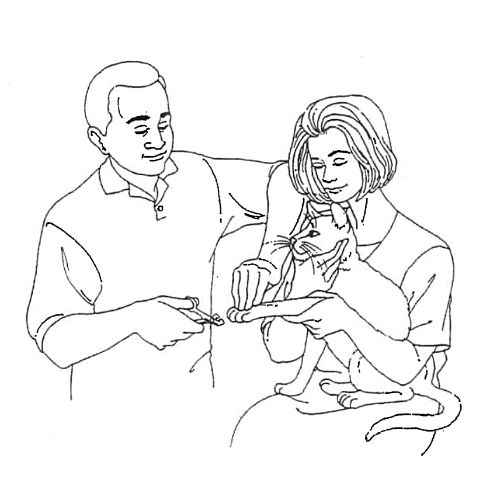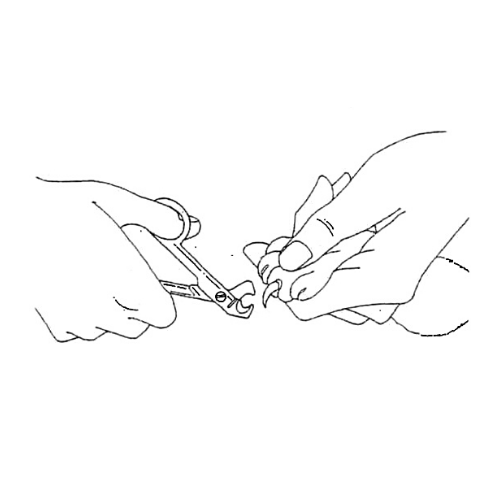Grooming
Keeping your cat or kitten clean and well-groomed is important to their overall health and happiness. This doesn't mean weekly baths, but there are important aspects in cat cleanliness and grooming that should not be ignored. For more information on skin and coat care, dental care and eye care, check out this cat grooming care guide.
How to Trim A Cat's Nails
Trimming a cat's claws every few weeks is a vital part of maintaining the animal's hygiene. Regular trimming not only protects the health of a cat's handlers but also guarantees the well-being of adopters' couches and armchairs. But if the idea of trimming a cat's claws has you biting your nails, know that all it takes is some patience, a little help from a more experienced person, and plenty of practice to sharpen your skills.
|
1. Stay on the Cutting Edge There are plenty of tools available to trim a cat's claws; use whichever one works best for you and the animal. Some people prefer a special pair of scissors modified to hold a cat's claw in place, others prefer human nail clippers, and still others choose plier-like clippers or those with a sliding "guillotine" blade. Whatever your tool of choice, be sure the blade remains sharp; the blunt pressure from dull blades may hurt an animal and cause a nail to split or bleed. |
 |
 |
2. Take Paws, Part 1 If you approach a cat with a sharp object in one hand while trying to grab a paw with the other, odds are you'll come up empty-handed. Because cats' temperaments and dispositions vary greatly, there is no "perfect" way to handle a cat while trimming his claws. Some cats do well with no restraint at all, but most cats need to be held firmly but gently to make sure that no one gets hurt. Try resting the cat in the crook of one arm while holding one paw with the other hand. Or, place the animal on an examination table and lift one paw at a time. You may even be able to convince a particularly sociable cat to lay back in your lap. |
|
3. Take Paws, Part II If you've got a helper, ask him to hold the cat while you clip the nails, or just ask him to rub the cat's nose or offer a special treat. If you're having a difficult time trimming a cat's rear claws, try gently scruffing the cat and laying him on his side, then have someone else trim the claws. |
 |
 |
4. Take a Little Off the Top Now that you're in position and the cat's in position, put the claw in the right position, too. Take a paw in your hand, curl your fingers into a fist, and use your thumb to gently press down on the joint just above the claw. When the claw extends, quickly but carefully snip off the sharp tip and no more. Don't get too close to the pink part of the nail called "the quick", where blood vessels and nerve endings lie. Just like the pink part of a human fingernail, the quick is very sensitive; cutting into this area will likely hurt the animal and cause bleeding. If this happens, apply a little pressure to the very tip of the claw (without squeezing the entire paw, which would only increase the blood flow) or dip the claw in a bit of styptic powder, then leave the cat alone, being sure to check on him regularly. |
|
When working with a long-haired cat, be sure the fur is clear of the clippers or you may pull the animal's fur, hurting the cat and hurting your chances of ever trimming his nails again. Dark coated cats may have darker nails which can make identifying the quick more difficult.
If you cannot identify the quick, clip immediately in front of the area where the nail starts to curve down. |
 |
|
5. Take it One at a Time If you aren't able to trim all 20 nails at once, don't worry! Few cats remain patient for more than a few minutes, so take what you can get, praise the animal for cooperating, then be on the lookout for the next opportunity - maybe even a catnap - to cut things down to size.
Nail Trim Guide courtesy of the Humane Society of the United States; illustrations by Susie Duckworth |
|
Declawing Information
Scratching
Scratching is a natural innate behavior of cats. It serves to condition the claws and to mark territory with scent from the paws. Their claws represent instinctive impulses to climb, chase, hunt and defend themselves. It may not be eliminated, but it may be redirected to an acceptable area.
The Declawing Issue
Declawing is unnatural and cruel and denies your pet its instinctive desire to scratch. It is even a safety peril for a cat if they find themselves outside, leaving it defenseless in the jungle beyond the doors. Most nationally recognized humane welfare organizations strongly discourage declawing, and several cities and states have made declawing illegal.
What Declawing Actually Is
Declawing is actually the surgical removal of the entire last digit of each toe, or amputation comparable to the removal of human fingertips to the first knuckle. Sensory and motor nerves are cut, damaged and destroyed. Although the procedure usually heals well and may not harm the cat, recovery from the surgery is a slow and painful process that follows with a lack of feeling, then a tingling sensation during the long convalescence. The cat must walk on the stub end of the second digit. If the surgery is not performed properly, the claws can grow back, but not in the normal way; rather they grow up through the top of the paw creating a bloody raw sore resulting in further corrective surgery.
Lifetime Consequences
Since cats are digitigrade (they walk on their toes), declawing can hamper the sensations and enjoyment involved in walking, running, springing, climbing, and stretching.
Numerous case studies confirm the fact that many cats suffer irreversible psychological damage when their natural defense system is removed. The nervous, defensive attitudes of many declawed cats suggest there is a heightened awareness of their vulnerability. Stress in cats can take its toll in a variety of health and behavior problems.
Many humane welfare workers see not only the lovable, well-behaved cats, but also the many that have been rejected by their guardians due to behavior or temperament problems. Euthanasia is often the sad ending for the declawed cat.
Declawed cats may exhibit one or more of the following problems:
- peculiar litterbox preferences resulting in litterbox avoidance
- unprovoked biting
- impaired balance and agility
- extreme timidity, especially with strangers or other animals
- lack of playful and vigorous activity in adulthood, resulting in obesity
Declawed cats must be restricted indoors for life. Should they slip outdoors accidentally or be relegated to a life outdoors for any reason, the cats would be at a disadvantage to defend themselves or escape from danger.
Alternatives to Declawing
- Scratching Posts
- Cats like to mark their territory in a prominent area, often near a favorite sleeping place, with visible and olfactory evidence of their presence. The scratching post or board should be of reasonable size and a prominent vertical stable structure covered with fabric, carpet, or sisal. It is ok to lay the post or board horizontally on the floor initially. Keep it in the area your cat/kitten spends the most time. Rub your cat's paws on the scratching post and the smell will encourage them to return. You may also use Sticky Paws, a tape-like product for your furniture that will prevent scratching damage.
- Training for the Older Cat
- The older cat may have to learn not to scratch an area they are using. Consider temporarily covering the furniture corner with plastic to change the texture, or moving the furniture. Place the new scratching post where the furniture corner was. After you have trained the cat to use the desired post, it can be moved by small increments to a more convenient location and your furniture returned to normal. Rub the cat's paws on the new post. If you have to reupholster, a fabric that is tightly woven nubby material may be less attractive to the cat than the longitudinally orientated fabric. For some cats, a squirt from the water sprayer may be added to discourage inappropriate scratching.
- Clipping Your Cat's Claws
- Nails trims are HIGHLY RECOMMENDED! By keeping your cat's nails trimmed on a regular basis (about every week or so) you can prevent a great deal of scratching. For information on how to properly trim cat nails please see the previous section.
- Soft Paws
- Soft Paws are soft, vinyl nail caps that are easily applied to a cat's newly trimmed nails. They are comfortable caps that cushion the effects of cat scratching, yet allow your cat to stretch and retract its claws naturally. Soft Paws are humane! They last about 4-6 weeks which is 5 times longer than nail trimming alone. Most veterinarians will apply Soft Paws on your cat if you do not feel comfortable or skilled enough yourself, they may even give you hands-on training so you can apply them in the future.




